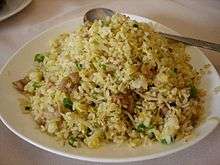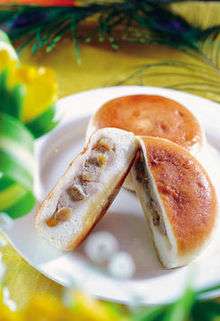Cantonese salted fish
Cantonese Salted Fish (simplified Chinese: 广东咸鱼; traditional Chinese: 廣東鹹魚; piyin: Guǎngdōngxiányú; also known as "Salted-fish, Chinese style") is a traditional Chinese food originating from Guangdong province. It is a fish preserved or cured with salt, and was a staple food in Southern China. It historically earned the nickname of the "poor man's food", as its extreme saltiness way is useful in adding variety to the simpler rice-based dinners. More recently it has become a popular cuisine in its own right.[1]
History
Beginning near the 15th century, China struggled with economic problems in the lower classes. Even relatively advanced cities like Guangdong had large populations without access to any kind of food preservation. More recently, this meant being without any sort of refrigeration. To overcome the rotting of room temperature meat, a number of methods became popular, such as canning and salting. The coastal Guangdong province includes fishes as a major food source, and the fishing industry was the most productive source. Thus food preservation efforts with focused foremost on fish, and the eventual convergence of these techniques gave eventual rise to the dish.
The presence of common salt, sodium chloride, helps to preserve salted fish, through inhibition of bacterial growth. When the solution of salt, or brine, is more concentrated—specifically, has a lower water potential—than the fluid of the fish tissue, osmosis will occur. Water molecules will pass from the fish tissue (higher water potential) into the brine (lower water potential) until the water molecules in these two solutions are evenly distributed. This is known as a hypertonic environment. Most bacteria cannot survive in such an environment, as their cells shrink and normal biological function cannot continue, eventually terminating in lysis. This lends the antiseptic properties, and hence preservational power, of salt.[2][3]
Varieties



A wide range of fish species can be prepared as Cantonese salted fish. The most common ones are Eleutheronema tetradactylum (mayau (馬友)) and Ilisha elongata (鰽白). Other types of fish, such as Pseudosciaena crocea (黃花魚) and Bahaba taipingensis (白花魚) can also be used.[4]
In addition to the different types of fish, Cantonese salted fish can be divided into two main types: méi-xiāng (梅香) and shí-ròu(實肉). For méi-xiāng (fragrant) salted fish, fish with thicker bodies such as Scomberomorus (jiaoyu (鮫魚))and mayau are preferred. It takes 7–8 days for méi-xiāng salted fish to ferment, after which it is seasoned with salt and dried in the sun. Méi-xiāng style salt fish has an intense salty fragrant flavour which makes it unsuitable to be eaten unaccompanied. Méi-xiāng salt fish , either when raw or after steaming, is usually shredded or cut into small pieces and used as a topping or seasoning.
Shí-ròu (實肉) (firm fleshed) salted fish does not need to be fermented], it is prepared by seasoning followed by direct sun and wind drying. Fish with thinner bodies such as Ilisha elongata are usually used to prepare shí-ròu. Unlike méi-xiāng salted fish, shí-ròu can be eaten directly unaccompanied after frying or steaming.
Methods
In Tai O,[5] a vertical marination method (插鹽) is the most popular way to prepare Cantonese salted fish. In this method, fish such as Ilisha elongata and mayau will first be gutted and then washed. The cleaned fish are inserted head down vertically into a heap of salt. Under gravity, the juice of the fish can flow out from the mouth of the salted fish. Through this method, the salted fish can be kept as dry as possible.
Dishes
- Boiled rice with steamed salt fish
- This is salt fish served at its simplest. A piece of salt fish is placed on top of boiled rice as it is cooking, the steam from the rice also cooking the fish. Once the rice has finished cooking the fish is shredded with the tip of a pair of chopsticks, the bones removed and the flesh mixed together with the rice.
- Steamed meat patty with salted fish ( 鹹魚蒸肉餅)
- This is a very popular dish among local restaurants and some chain restaurants. It is also an extremely common home made dish.[6]
- Chicken and salted fish fried rice ( 鹹魚雞粒炒飯)
- This is a fried rice dish with chicken and salted fish. Most cha chaan tengs have this dish and it is popular among local people.[7]
- Salted fish bun (鹹魚大包)
- The salted fish bun was a favourite dish of the Qing Dynasty Kangxi Emperor. It is a kind of baozi (Chinese steamed bun) with a filling of sliced pork and salted fish.[8]
- Salted fish head with beancurd soup (鹹魚頭豆腐湯)
- The ingredients of this soup include ginger, salted fish, and beancurd.[9]
Culture
Slang
In Cantonese slang dead bodies are referred to as salted fish, and a number of other phrases derive from this usage. ‘Xian yu fan sheng’ "A salted fish coming back to life" is slang meaning that something that is saved or revived when it seems that it is dying or has little chance of surviving, it is also used to describe a person or an organisation making a comeback after an event that would normally be career ending. ‘Shi de xian yu, di de ke’ is slang which means that "those who eat salted fish must put up with the thirst"; this is a popular slang to tell people that they have to bear the consequences of their actions.
Song
A famous song named ‘Without the Two of Us’ by Hong Kong popular singer George Lam, has a line related to salted fish. The line is ‘And even salt fish and pak choi will taste really really good’. As salted fish is the symbolic dish of the poor, this line make the allusion that with love even a simple and humble life is enough.
Movie
The Hong Kong comedy movie, Shaolin Soccer references salted fish in the line, "If we don’t have any dreams in life, we will look like a salted fish". This line became popular in Hong Kong, and has been mistaken for a traditional Chinese saying, it has even been cited in public examinations.
Scientific Research
In scientific research, salted fish has been considered possible risk factor in nasopharyngeal carcinoma(NPC). In 1967, Ho presented evidence that the Tankas (boat people), who consume Cantonese salted fish in their daily diet, had twice the incidence of NPC compared with the land-dwelling Cantonese in Hong Kong. Since salted fish is traditionally eaten with rice, part of a staple diet for children and the poor segment of Southern China, these are the populations that are at highest risk of NPC. Further research has since shown that, broadly, the residents of Southern China are more at risk than other countries, supporting the theory that the food has a link to NPC.[10][11]
References
- ↑ chinesesaltedfish 'Chinese Salted Fish'
- ↑ saltedfishSalted fish'Salted fish'
- ↑ nzd 'Fish Handling, Preservation & Processing in the Tropics: Part 2 (NRI)'
- ↑ 香港食物規格資料庫魚乾類 '香港食物規格資料庫-魚乾類'
- ↑ 鹹魚鹹魚'鹹魚'
- ↑ foodno1 '鹹魚蒸肉餅'
- ↑ 鹹魚雞粒炒飯 '鹹魚雞粒炒飯'
- ↑ stheadline '創新清宮宴 香脆惹味鹹魚包'
- ↑ openrice 'Salted fish head with beancurd soup'
- ↑ sciencedirect 'Salted Fish & Nasopharyngeal Carcinoma'
- ↑ chinesesaltedfish” 'Chinese-style Salted Fish'